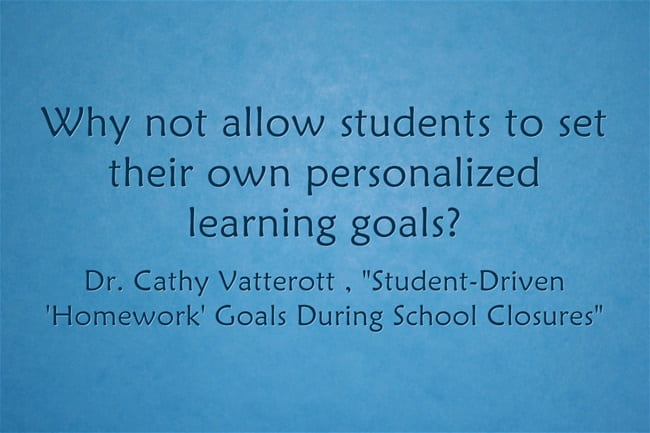Note: I’m adding this guest post to The Best Advice On Teaching K-12 Online (If We Have To Because Of The Coronavirus) – Please Make More Suggestions!
Cathy Vatterott is an educational consultant and professor emeritus at the University of Missouri-St. Louis. She is the author of Rethinking homework: Best practices that support diverse needs, 2nd edition (ASCD, 2018) and Rethinking grading: Meaningful assessment for standards-based learning (ASCD, 2015).
If so many parents already find homework a battle, how do teachers plan for weeks of homebound student learning in the middle of a global pandemic? Good luck getting students to complete those overly prescribed learning tasks like worksheets and required reading. Good luck getting parents to become the “homework cops” while they are simultaneously working from home.
Teachers, this is the perfect time to allow students to take ownership of their learning. Instead of struggling to create at-home lessons, why not allow students to set their own personalized learning goals? Students, here is your homework for the next few weeks:
Week one: no homework spring break: Sleep, play, relax, spend time with your family
Week two and beyond:
Step 1: For each school subject, write a goal you want to achieve, create a plan for how to get there, and a way to show your teacher that you have reached your goal. Maybe your goal is a skill you want to get better at (like reading, writing, math, Spanish). Your teacher may have suggestions for you. Maybe your goal within a subject is to learn more about something you are interested in or something you know nothing about. Don’t forget to include goals for health and physical education. The way you show what you have learned is up to you–it could be a project, a video, a paper, or a test you give yourself. Submit your goals to your teacher and parents for approval. The important thing is to keep your brain learning!
Step 2: Decide on how you will organize your learning. Will you complete one subject goal at a time over a period of days, will you work on each subject a little every day, or will you designate specific days for specific subjects (math on Mondays, science on Tuesdays, etc.).
Step 3: Design your daily Monday through Friday schedule to include a total of at least 20 hours of focused learning for the week. Focused learning means without the distraction of television, music, cell phones or other social media. The time can be scheduled any way you like—all at once, one hour at a time, four hours a day for five days, longer hours on fewer days, etc. Have your parents sign off on your schedule.
Step 4: Decide where you will work, what resources you need, and how you will document your time. (If you get really excited about your learning, you may choose to work longer!)
Step 5: Give yourself a deadline for each goal. When you believe you have a method to show you have reached the goal, submit your proof to your teacher and parents.
For both teachers and students, the most important thing is for students to continue to learn and for teachers to continue to provide feedback, direction, and encouragement for that continued learning.




Recent Comments